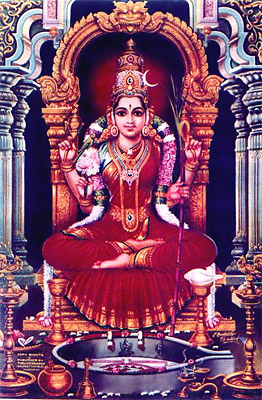 Tripura Sundari is one of the most popular deities that are worshipped in Tripura. She is the third goddess of the Ten Mahavidyas that are associated with the Hindu religion. The goddess is described as being the consort of Lord Shiva.
Tripura Sundari is one of the most popular deities that are worshipped in Tripura. She is the third goddess of the Ten Mahavidyas that are associated with the Hindu religion. The goddess is described as being the consort of Lord Shiva.
Goddess Tripura Sundari is often referred to as Shodasi. Shodasi is commonly represented in the state as a girl of sixteen years. She represents sixteen different types of urges. The Shodasi Tantra is an important source of information about Tripura Sundari in Tripura. According to this source, Tripura Sundari is actually the illumination in the eyes of Lord Shiva.
Tripura Sundari is also known as Goddess Sodasi, Goddess Kamesvari, Goddess Lalita and Goddess Rajarajeshvari. The goddess is known as an Adi Mahavidya and represents a complete version of reality. She is also regarded as the penultimate vision of enlightened consciousness. Her dhyana mantra also describes her as the Goddess who shines with the light of the rising sun. Her four hands hold a noose, a goad, arrows and a bow. In Lalita-Sahasranama she id described as being seated on a throne like a queen. She beautiful body is adorned with elegant jewellery. A crescent moon is seen on her forehead. She is seated on the corpses of Lord Brahma, Lord Vishnu, Lord Shiva and Lord Rudra. Tripura Sundari is attended by Brahma, Vishnu, Shiva, Goddess Lakshmi and Goddess Saraswati.
The iconography of Tripura Sundari depicts her seated on lotus that is placed on the supine body of Lord Shiva. It rests on a throne whose legs are Lord Brahma, Lord Vishnu and Lord Rudra. Certain iconography depicts the lotus growing out of Shiva`s navel while others portray it growing from Tripura Sundari`s yantra Sri Cakra. According to Vamakesvara- Tantra Tripura Sundari resides on the peaks of Himalaya Mountain. She is worshipped by saints and heavenly nymphs. The goddess is depicted as wearing a Tiger Skin and has a snake as her garland around her neck. Her body like pure crystals and her hair is tied like a jata. In her two hands she holds a trident and a drum. She has a huge bull as her vehicle and is adorned with beautiful jewels and flowers.
Goddess Tripura Sundari is an integral part of the religious life of Tripura. It is commonly believed that the state of Tripura has derived its name from Tripura Sundari. One of the main temples of Tripura known as Tripura Sundari Temple is dedicated to the Goddess. The temple is situated at the top of a hill close to the village called Radhakishorepur in ancient Udaipur. The importance of Goddess Tripura Sundari in Tripura can be recognized from the fact that it is considered one of the fifty one pithasthanas associated with the religion of Hinduism.




















